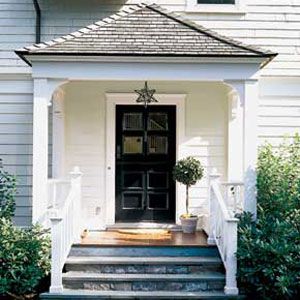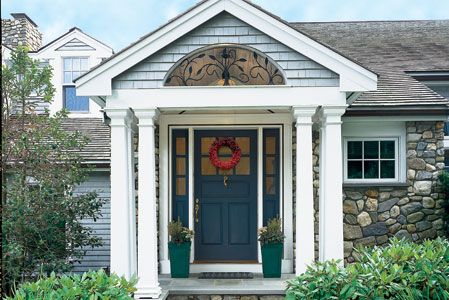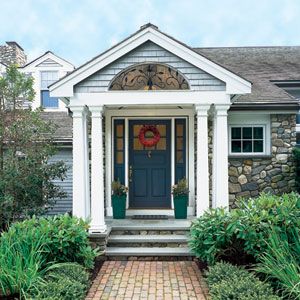
Ever visit a friend who’d just finished a serious renovation? Did you have that grudging admiration heading up the new walkway, that slight hollow in the belly as you climbed the steps to the new front door?
New Take on Tradition
A gabled portico with six tapered columns (above) and a fanciful interpretation of a fanlight — a half-round cut-out in the gable with wrought-iron grillwork — gives presence to the entry of this newly built seaside “cottage” but keeps the mood informal. To add another level of detail, architect Thad Siemasko inlaid a band of purpleheart wood in the white-painted trim surrounding the the door and sidelights. The fieldstone on the stair risers and the shingles and wood trim on the gable echo elements used elsewhere on the house.
Well, that’s all just envy. What you should have sensed was what your buddy surely intended: a greeting at the gateway to his home that felt like a good handshake: solid, friendly, and wanting to impress.
A well-designed entryway delivers just that, making anyone passing through it feel a little important and very welcome. “What’s key,” says Thad Siemasko, the architect who designed the house shown here, “is that an entry be inviting, and that it enhance the character of your house.”
From a practical standpoint, it should provide a place for packages and mail, and give visitors well-lit shelter from the elements. “It’s not very gracious to make guests stand in the pouring rain,” comments architect McKee Patterson, who says about half of his renovation projects include improving the entryway. “Think of the area as an extension of your foyer.”
Yet many homes do have entries that are less than gracious, especially if they were put up in the past 40 years. If yours falls into that camp, adding an entry porch, or portico, is one sure way to endow it with a friendlier facade. Often it’s the one feature that gives a plain house character.
If you want to open the door to that kind of improvement, read on — you’ll find the best advice This Old House has to offer.
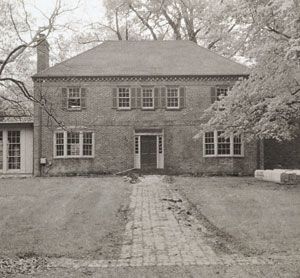
A Matter of Style
A well-designed entry should reflect the architectural heritage of the house, set the stage for what’s to come once you enter, and address a few practical concerns. It should be appropriately scaled to its surroundings: Consider the two-story porch on a Southern plantation house, or the simple header and wide trim boards used on a small, vintage Colonial. “Think of an entry not as a separate entity but as part of a whole,” says McKee Patterson, whose architectural firm is located in Southport, Connecticut. “All the elements should work together as a composition, so it looks like it’s always been there.”
Ideally, an entry should offer some overhead protection, not just to shelter guests but also to keep the door from being pounded by the elements. Sometimes this shelter is already built into the style of a house — there are deep roof eaves over the door, say, or a full front porch with a recessed entry; then you can concentrate on improving the landing, lighting, and front door itself. Otherwise, you may be looking at renovating or adding on a separate portico roof. These can range from a simple gable overhang supported by wooden brackets to a wide semicircular flat roof with stately columns beneath. Perhaps the most traditional take is a classical pediment supported by two or more columns, a form that has reigned over American doors since the Greek Revival period of the mid-19th century.
Because doors are always built above grade, steps and a landing also factor into the entryway equation. “Even a step-up of six inches creates a nice threshold,” says Patterson. If there is a natural stone walkway or garden path nearby, stone steps can connect the entry to the surrounding landscape. The steps can also echo a material used on the house itself. A brick house with matching brick steps has a cohesive look, as do wooden steps and railings detailed or painted to match window, porch, or roof trim.
The front door should have much more detail than the rest of the house because it will be viewed from just inches away, says architect Thad Siemasko. He likes to accent door trim with exotic wood inlays and incorporate decorative motifs that mirror trim details used elsewhere on the house. Sidelights, and a transom or fanlight above the door, can add period detail and also bring light into a dark vestibule.
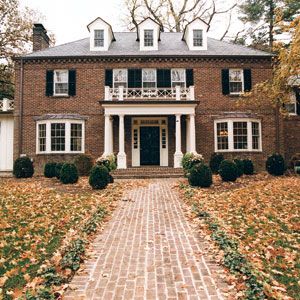
Practical Pointers
An entryway landing should be at least 6 feet wide, so two people can stand side by side at the door, says architect and TOH contributor Duo Dickinson, whose bold entryways are one of his signatures. And it should be at least 4 feet deep, so an outswinging storm door won’t send visitors tumbling off the steps. Homes with a small vestibule benefit from a larger entry porch landing; building in benches makes it convenient to remove boots, or set down groceries while you unlock the door.
To shed rain effectively, the porch overhang needs to be a minimum of 2 1/2 feet deep, but it should generally cover the whole depth of the landing. If it’s gabled, rain will naturally drain off the sides, but a shed roof (a flat roof that slopes forward) will need a gutter along the front edge. For those who live in cold climates, radiant heat underneath the entry landing and stairs is a luxurious way to keep the porch clear of ice and snow.
While an entry needs to be lit for safety and security, lighting also creates a mood. Typically, there’s a pendant or recessed fixture in the ceiling of the overhang to illuminate the landing. Wall sconces flanking the door accent the door itself and usually reflect the style of the house: Curved copper onion lamps might accent a Colonial Revival house, for instance, and rectangular bronze lanterns could be used on a Craftsman bungalow. Sconces are a good place to put your money because these will be seen up close by visitors, says Dickinson, who is based in Madison, Connecticut.
So close, in fact, that Dickinson cautions against making your entry glaring; the goal should be a warm glow. “Too many entryways I see are overlit,” he says. “Where there are sidelights, the light coming from inside the house can be quite significant.” For the best lighting control, he recommends putting entryway lights on a dimmer switch.
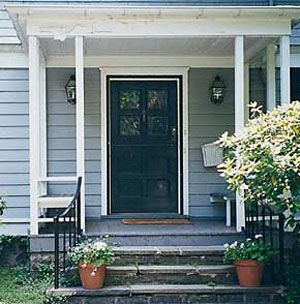
Building to Last
Because they are very exposed to the elements, entries get especially weather-beaten. Cedar, redwood, and mahogany are all good choices for wood trim elements, says This Old House general contractor Tom Silva. “These days we’re also using a lot more man-made materials, like cellular PVC trim, which lasts forever and is impervious to water.”
Columns are a particular weak point because water is wicked up by the base, even on an elevated porch, causing them to rot. Wood columns built to last should be raised up off the landing, using special galvanized metal brackets. Tom hides the gap around the bottom with baseboard material — preferably cellular PVC stock. All wood columns should be treated thoroughly with a water-repellent wood preservative before being painted, or sealed and treated with an exterior stain.
Brackets that support an entry roof need to be substantial — at least 4 inches in both dimensions, says Dickinson, who prefers brackets made of laminated redwood stock. Some contractors make brackets out of solid cedar fence-post material, which can be cut and shaped using a router.
All brackets should be anchored to the wall with galvanized or stainless steel lag bolts and attached not to the sheathing but to the structure of the house. Tom recommends hiring an engineer if you’re planning to support a sizable roof on brackets, especially in snow country. But wherever you live, even small overhangs should be built to be as strong as any other roof. Siding on the house at the roofline must be removed before roof installation, and the sheathing should be flashed with a waterproof membrane and metal sheets.
When in doubt, Tom says, it doesn’t hurt to “overbuild” an entryway. Nothing looks more unwelcoming than a sagging, poorly made portico. “It’s a relatively small element of the house, so the materials won’t break your budget,” he says, and considering the dual benefits of good looks and function, it’s home-improvement money well spent.
